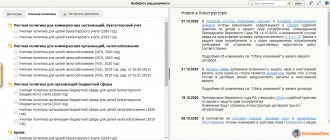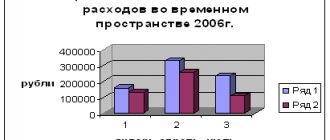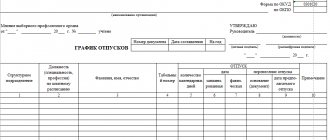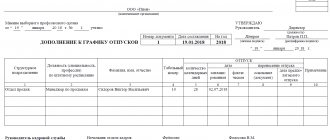Who needs a schedule and why?
Each department processes a large number of different documents per day. With the spread of electronic document management, the number of papers has decreased, but this has little effect on the system of interaction between departments of the enterprise. The presence of an approved document flow schedule in any organization facilitates the task of storing and processing incoming and outgoing documents.
This internal act is used by employees of the accounting department, production and sales departments, secretaries and other employees through whom a certain number of papers pass daily. A well-designed document flow plan and schedule will allow you to avoid:
- loss of documentation;
- non-reflection or untimely reflection in the accounting of facts of economic life;
- fines from regulatory authorities.
Drawing up a schedule is especially important for companies that have branches and separate divisions in their structure. If the EDI system is not used, the risks of paper loss increase significantly.
Use free instructions from ConsultantPlus experts to properly organize document flow in your organization.
Order on timely submission of documents to the HR department
Question: Does the employer have the right to oblige employees to promptly provide information about changes in their personal data (passport data, registration address, marital status, birth of children, telephone number, etc.)? Does he have the right to apply disciplinary or financial liability in the event of untimely submission of information about changes in his personal data and in the case of submission of documents containing false information (personal data)? Most likely, a lot of time will have to be devoted to the development of the regulations, since it is important to take into account all the features of business processes in your company. And the larger the organization, the more procedures need to be described.
But the efforts will eventually pay off, and there will be fewer late papers. Documents enter the accounting department from all divisions of the company. To ensure that papers are delivered on time, the organization usually develops a document flow schedule. But even if these regulations are approved, not all services comply with the deadlines. At the end of the year, in emergency mode, it is not easy to collect the primary. A special order from the director will help with this.
You will find a sample order for the provision of documents below. The correct execution of these documents is of great importance for the recognition of expenses. The schedule must also describe the process of movement of documents confirming certain facts of economic life, the occurrence of which the accountant may not know, but which must be reflected in the accounting. Having considered the issue, we came to the following conclusion: The employer has the right to establish in the local regulatory act of the organization the procedure for employees to provide information about changes in their personal data (passport data, marital status, information about children and place of residence). First of all, the document must list the primary information that the employees did not submit within the deadline established by the schedule. And also set a deadline for when the papers must be submitted.
The order can list the measures that will be applied to those who violate deadlines - a reprimand or reduction of part of the bonus. The heads of departments must be familiarized with the order.
Who shapes it
Since most finance-related papers are processed and stored in the accounting department, and incoming and outgoing letters are under the responsibility of the secretary or office manager, sometimes the question arises who develops the document flow schedule in the organization and who approves it.
Typically, the development is carried out by the chief accountant, who is responsible for the correct and timely reflection of business transactions in accounting.
Example: a delivery note and an invoice, along with the goods, first go to the warehouse, where an employee signs for receipt of the goods and checks the quantity and integrity of the packaging. Then the documents are transferred to the purchasing department, where the operator enters data on the receipt of goods and materials into the program. After this, the papers go to the accounting department, where the correctness of prices and quantities is checked, the accountant reflects VAT in the accounting and registers the invoice in the purchase book.
For internal acts not related to finance (fire safety instructions, cleaning schedules, etc.), the manager has the right to appoint persons directly related to them as responsible for monitoring the implementation of relevant activities.
Accounting policy is a mandatory component of document flow
The provisions on accounting policies have been in effect since the times of the USSR, since 1983! Accounting has never been the heart of business, but it has always been its fundamental basis.
Responsibility for developing accounting policies usually falls on the shoulders of the chief accountant and is approved by the head of the enterprise. The primary document goes through the following stages:
- Creation or receipt.
- Acceptance for execution and processing.
- Transfer to the archive.
Any action with a primary document is characterized by:
- source or sender of the document;
- recipient or executor;
- date of acceptance for execution;
- execution time;
- the recipient of the execution result.
Any primary document has significant content, and in the process of its movement it is supplied with status indicators that make it possible to monitor compliance with the accounting policies approved at the enterprise.
Usually a document flow schedule is drawn up for accounting policies in the accounting department, but it is available and mandatory for all divisions of the enterprise within their competence.
Compilation rules
The document is drawn up in the form of text, table or diagram indicating the names and positions of the responsible persons. When there are changes in the staffing table (hiring and dismissal of employees, transfers to other positions) and changes in job descriptions, changes are made to the document flow procedure: a new act or additions to it are drawn up.
The main purpose of drawing up a schedule is to ensure operational accounting of business transactions. Consequently, the period during which the document is in each department is set to a minimum.
Particular attention should be paid to the confidentiality of information contained in individual documents. The list of persons having access to them is strictly limited.
Regardless of who draws up the document flow schedule, the procedure is approved by order signed by the manager. All persons responsible for the preparation, storage and processing of paper and electronic documents sign to confirm that they are familiar with the procedure and undertake to comply with it.
Document flow: we build it “according to accounting”
- the head of the organization or an official authorized by him signs the orders;
- the office management service registers orders within document flows and the calendar year, forms original orders into files in accordance with their storage periods (the corresponding headings are reflected in the nomenclature of files);
- all interested departments and employees receive from the office management service copies of orders for execution or for guidance in work (or access to electronic copies of orders in the EDMS).
Copies of orders are usually kept until no longer necessary, but as documented grounds for making appropriate accounting entries, copies of orders for administrative and economic activities can be formed into accounting documents of the day and stored for at least 5 years or until the completion of the audit (audit).
How to approve
After the schedule is drawn up, an order is issued for its approval, in which the head of the company puts his signature under the heading “APPROVED”. Sometimes the question arises whether the document flow schedule is approved by the head of the organization if the document is drawn up for the internal document flow of a branch or separate division. In this case, the order is approved by the head of the branch or separate division. A separate order is drawn up for the exchange of documents with the head office.
Register of transfer of documents to the accounting department sample
ORDER In order to organize rational document flow, I ORDER: 1. All employees of Kalinka LLC, when drawing up, receiving, processing and transferring documents, are guided by the document flow schedule. 2.
Strictly comply with the deadlines for transmitting documents established by the document flow schedule. 3. Entrust control over the execution of the order to the chief accountant.
It is possible to include in the bonus regulations a condition regarding a reduction in the size of the bonus or a reduction in bonuses if the deadlines for the transfer of documents are violated. This is an extreme measure, but punishment in rubles is usually the most effective.
Exchange of experience Larisa Aleksandrovna Kosnicheva, chief accountant of MM Industry LLC “The difficulty in implementing a document flow schedule also lies in the fact that not all employees are ready to comply with it. One of the effective ways to oblige employees to comply with the schedule is to vary the size of the bonus.
Document status indicators
It is difficult to find an enterprise that does not use an electronic document management program, but even in an enterprise that does not have a single computer, the creation or receipt of a primary document is accompanied by the creation of an “indicator” of its status.
For large enterprises with numerous divisions and remote branches, monitoring the status of all documents is mandatory and a separate production process. Here, the document flow schedule for the accounting policy is a sample, and the actual state is the basis for optimizing the schedule, clarifying deadlines, punishing violators and determining ways to solve emerging production difficulties.
It is important to note that many events are extremely time-critical:
- reporting to the tax office;
- payment of taxes;
- submission of electronic declarations;
- other legally required actions.
While disruptions to the internal production cycle can somehow be neutralized, in relations with government agencies this is impermissible and is fraught with serious sanctions or losses.
Quick calculation of document flow volume
First of all, it should be noted that the rules for calculating and analyzing the volume of document flow are prescribed in the “Rules of Office Work”, which were approved by Decree of the Government of the Russian Federation dated June 15, 2009 No. 477 (as amended on September 7, 2011).
Secondly, you need to understand that such a calculation can be carried out just once a month, once every 3 months, once every six months and once a year. In each specific organization, the manager resolves this issue with the help of an internal order.
In this case, in any case, the basis for the calculation is the accounting and registration forms filled out by local clerks.
So, one unit of account is:
- original document
- a copy of the document, but only if there is no original and a copy in the singular. All other copies are counted separately
- documents attached to the cover letter (all considered together)
Complaints and suggestions are considered separately.
So, to quickly calculate the volume of document flow, use the following formula:
Total document flow = a / a1 + b / b1 + c / c1, where:
- a is the number of received documents, a1 is the number of copies of received documents
- b – number of documents sent, b1 – number of copies of documents sent
- c - number of internal documents, с1 - number of copies of internal documents
Document flow schedule for accounting policies: example content
The form of the document described is not significant. As usual, it is developed by the chief accountant, approved by the head of the enterprise and is presented as a table. We present to your attention an example of such a graph.
Each document has a name, and all rows of the table are numbered. The minimum requirement is two columns:
- creating or receiving a document;
- document verification and processing.
The first column contains two positions:
- responsible (employee, department);
- period of execution.
Second column - three or four positions:
- responsible for verification (execution);
- period of execution;
- deadline for transfer to the parent organization;
- form of registration of the result of execution.
Enterprises are not limited in the wording of the table header, reflecting the document flow schedule for accounting policies. The sample below shows one option.
It is important that the logic of the table must reflect exactly: what document, how it appears, by whom and where it is sent, by whom and when it is executed, and where the result is sent. Additionally, it is possible to provide for the actual delivery of the spent primary material to the archive. Typically, the document flow schedule for the accounting policy of a government institution is accompanied by regulations for working with archival documents. In relation to state entities, this is enshrined in law.








